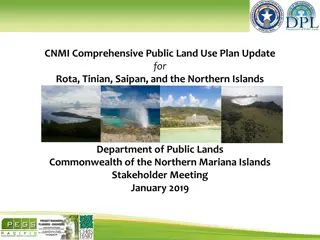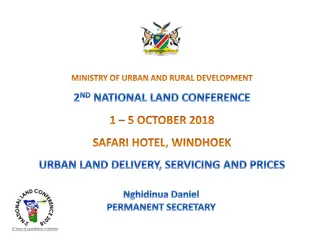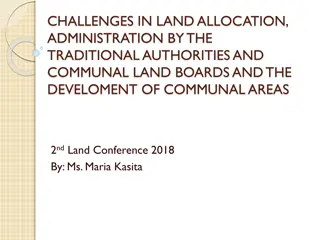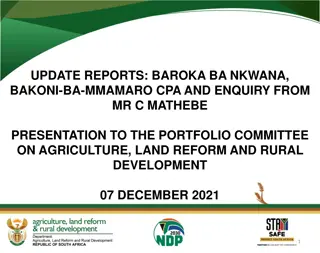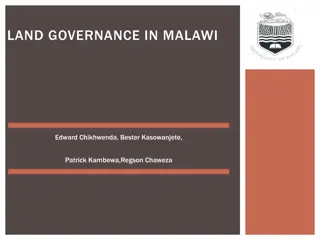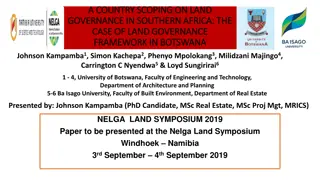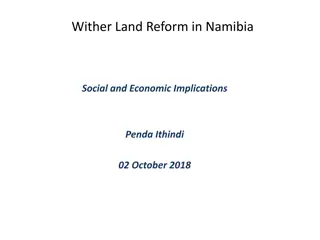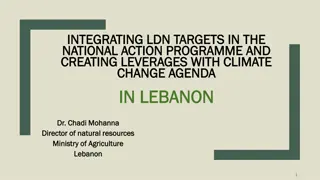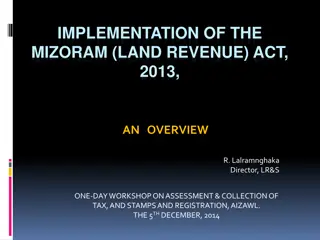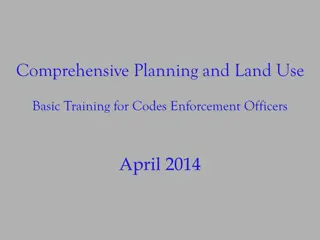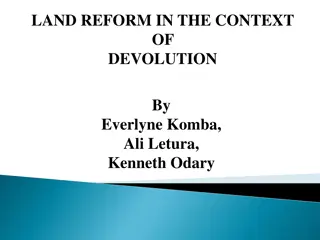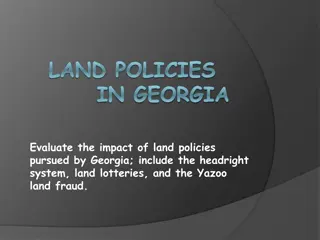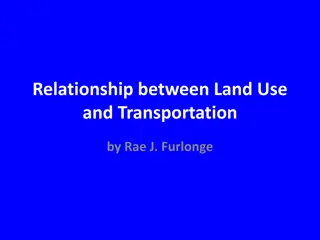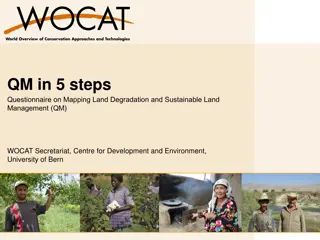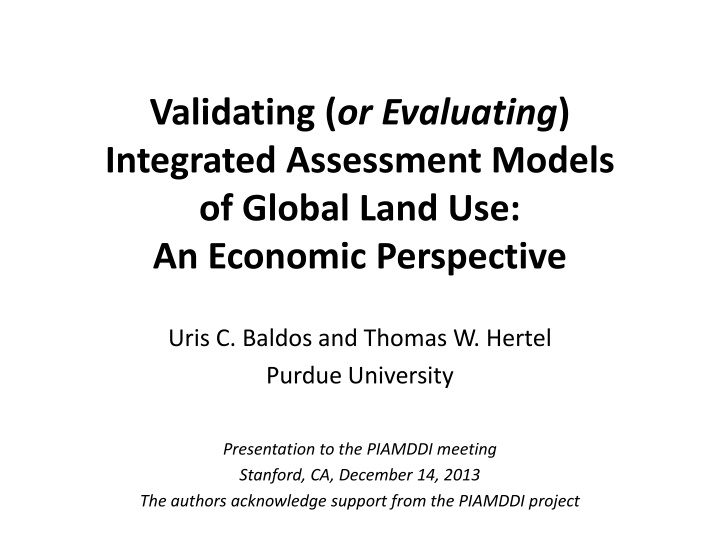
Validating Integrated Assessment Models of Global Land Use
Land-based activities contribute significantly to GHG emissions, prompting the need for rigorous testing of Integrated Assessment Models. The presentation discusses the importance of validating these models against historical data, focusing on key stylized facts and global land use changes.
Download Presentation

Please find below an Image/Link to download the presentation.
The content on the website is provided AS IS for your information and personal use only. It may not be sold, licensed, or shared on other websites without obtaining consent from the author. If you encounter any issues during the download, it is possible that the publisher has removed the file from their server.
You are allowed to download the files provided on this website for personal or commercial use, subject to the condition that they are used lawfully. All files are the property of their respective owners.
The content on the website is provided AS IS for your information and personal use only. It may not be sold, licensed, or shared on other websites without obtaining consent from the author.
E N D
Presentation Transcript
Validating (or Evaluating) Integrated Assessment Models of Global Land Use: An Economic Perspective Uris C. Baldos and Thomas W. Hertel Purdue University Presentation to the PIAMDDI meeting Stanford, CA, December 14, 2013 The authors acknowledge support from the PIAMDDI project
Background and Motivation Land-based activities are a large source of GHG emissions and could potentially offer 50% of efficient global abatement in the near term. IAMs have recently incorporated land use in their analyses. However, little work to date on testing these models against history. We aim to nudge this process ahead. We pick up on several emerging themes from PIAMDDI and AMPERE: Focus on validation wrt a key stylized fact for one component of IAM (Schwanitz) Approach is one of hindcasting (Smith et al.) Emphasis on global land use change (JGCRI: Wise et al., Calvin et al.; MAgPIE) Key role for thoughtful experimental design (Karl Taylor: PCMDI) Consider presence of error signatures in economic models of cropland We also adhere to the KISS principle of keep it simple
The Key Stylized Fact in Global Land Use Over the past 50 years, global crop output has tripled, yet only a small fraction of this has come from area expansion. 85% of the Expansion has come from intensification: increased yields, cropping intensity. If the world can reproduce this experience over the next 50 years, then we are in luck . If we must mostly expand area to feed 2 billion more people and significantly upgrade diets for more several billion additional individuals, currently at low income levels, then we are in trouble So the key question is: Can this experience be repeated? We don t know the answer, but it is clear, if we are using models which cannot reproduce this historical outcome, then there will be little confidence in their projections of the future. To answer this, developed SIMPLE = a Simplified International Model of agricultural Prices, Land use and the Environment
SIMPLE: A model of global agriculture Global partial equilibrium model o Food sectors include crop, livestock, processed foods o 7 Geographic regions (crop supply and cropland use) o Both Land and Non-land inputs are less than perfectly elastic in supply o 5 Income regions (derived demands for crops, livestock and processed foods) Global market clearing condition for crops o Single world crop price o Regional market clearing conditions for livestock and processed foods Tracks changes in the following: o Cropland use and GHG emissions from cropland change (two types of conversion: cropland to other lands & other lands to cropland) o Agricultural investments in research & development facilitate adaptation to higher temperatures, changing precipitation o Distribution of nutritional attainment by demand region
Exploring SIMPLE (1): Food demand is fueled by population & income while bioenergy use place additional demand for crops Consumption by 5 Income regions Demand Food Security Outcomes INCi y Population ( , ) Per Capita Demand Income per capita Demand Response Food Consumption Global Crop Market Global Biofuel Use
Exploring SIMPLE (2): Crops are produced using land & non-land inputs with the possibility of input substitution Consumption by 5 Income regions Demand Food Security Outcomes INCi y Population ( , ) Per Capita Demand Income per capita Demand Response Food Consumption Global Crop Market Market Global Crop Global Biofuel Use Input Substitution Non Land Inputs Land Inputs CROP Supply Crop Production by 7 Geographic regions
Exploring SIMPLE (3): Prices mediate food demand, input supply and equilibrate the global market for crops Consumption by 5 Income regions Demand Food Security Outcomes INCi y Population ( , ) Per Capita Demand Income per capita Demand Response Food Consumption ( , ) Pi y Food Prices Global Crop Market Market Global Crop Global Biofuel Use Global Crop Price Input Prices Input Substitution Non Land Inputs Land Inputs Non Land Price Response CROP NLAND LANDg ( ) Land Rent Response Supply Crop Production by 7 Geographic regions
Exploring SIMPLE (4): Economic responses to scarcity endogenously mediate cropland use Consumption by 5 Income regions Demand Food Security Outcomes INCi y Population ( , ) Per Capita Demand Income per capita Demand Response Food Consumption ( , ) Pi y Food Prices Global Crop Market Global Biofuel Use Global Crop Price Input Prices Input Substitution Non Land Inputs Land Inputs Non Land Price Response CROP NLAND LANDg ( ) Land Rent Response Supply Crop Production by 7 Geographic regions
Exploring SIMPLE (5): Crop productivity is affected by exogenous technological progress & climate change impacts Consumption by 5 Income regions Demand Food Security Outcomes INCi y Population ( , ) Per Capita Demand Income per capita Demand Response Food Consumption ( , ) Pi y Food Prices Global Crop Market Global Biofuel Use Global Crop Price Input Prices Input Substitution Land Use GHG Emissions/ Sequestration Non Land Inputs Land Inputs Non Land Price Response CROP Crop NCrop LCF ( ) g NLAND NCrop Crop LCF ( ) g LANDg ( ) Emission Factors Land Rent Response Climate: Temp, Precip & CO2 Crop Investments in Ag. R&D EINV Productivity Growth Investment -Yield Response Supply Crop Production by 7 Geographic regions
Validation: Can we predict historical changes in output, price & the mix of extensive & intensive contributions? Actual Data Baseline 250 206 196 181 200 162 150 in % change 100 50 17 16 0 -24 -50 -29 -100 Crop land Crop Yields Crop Production Crop Price Historical validation over a 45-year period (1961-2006) Exogenous drivers are pop, income & estimated total factor productivity growth by region and sector Results at the regional level are less satisfactory for many regions owing to integrated world market assumption
Using SIMPLE as a laboratory to explore economic limitations of existing IAMs While SIMPLE is simple in its representation of biophysical processes and spatial resolution, it is richer in economic structure than many IAMs it can be used to explore the implications of omitting key economic factors Revisit historical validation with the restricted model: Fixed per capita demands (income and price are no longer drivers of food demand) Constant income & price responses over time (invariant to income level) Absence of endogenous intensive margin (yield is driven by exogenous productivity growth) Purely biophysical approach (omit economic responses)
SIMPLE w/ Fixed per capita demands Food Security Outcomes Population INCi y ( , ) Per Capita Demand Income per capita Demand Response Food Consumption ( , ) Pi y Food Prices Global Crop Market Global Biofuel Use Global Crop Price Input Prices Input Substitution Land Use GHG Emissions/ Sequestration Non Land Inputs Land Inputs Non Land Price Response CROP Crop NCrop LCF ( ) g NLAND NCrop Crop LCF ( ) g LANDg ( ) Emission Factors Land Rent Response Climate: Temp, Precip & CO2 Crop Investments in Ag. R&D EINV Productivity Growth Investment -Yield Response
Implications of fixed per capita demands Actual Data Scen. 1 Actual Data Scen. 3 250 % cumulative change: 1961-2006 % cumulative change: 1961-2006 250 188 200 200 150 150 105 104 96 100 100 41 50 50 0 0 -1 -4 -50 -50 -53 -100 -100 Crop Crop Yields Crop land Crop Price Crop Crop Yields Crop land Crop Price Production Production With fixed per capita consumption, composition of diets is unchanging Actual Data Scen. 4 Actual Data Scen. 2 % cumulative change: 1961-2006 production, yields and cropland growth rates 250 235 % cumulative change: 1961-2006 250 200 178 200 175 154 150 150 100 100 Error signature: leads to underestimation of global 50 50 22 13 9 0 0 -16 -50 -50 -100 -100 Crop Crop Yields Crop land Crop Price Crop Crop Yields Crop land Crop Price Production Production
SIMPLE w/ constant income & price responses Food Security Outcomes Population INCi y ( , ) Per Capita Demand Income per capita Demand Response Food Consumption ( , ) Pi y Food Prices Global Crop Market Global Biofuel Use Global Crop Price Input Prices Input Substitution Land Use GHG Emissions/ Sequestration Non Land Inputs Land Inputs Non Land Price Response CROP Crop NCrop LCF ( ) g NLAND NCrop Crop LCF ( ) g LANDg ( ) Emission Factors Land Rent Response Climate: Temp, Precip & CO2 Crop Investments in Ag. R&D EINV Productivity Growth Investment -Yield Response
Implications when demand responses do not evolve with income If demand response does not evolve with income, consumers will spend additional income on the same commodity/food Actual Data Scen. 1 Actual Data Scen. 3 250 % cumulative change: 1961-2006 % cumulative change: 1961-2006 250 188 200 200 150 150 105 104 96 100 100 41 50 Error signature: leads to the overestimation of global production, yields and cropland 50 0 0 -1 -4 -50 -50 -53 -100 -100 Crop Crop Yields Crop land Crop Price Crop Crop Yields Crop land Crop Price Production Production Actual Data Scen. 4 Actual Data Scen. 2 % cumulative change: 1961-2006 250 235 % cumulative change: 1961-2006 250 200 178 200 175 154 150 150 100 100 50 50 22 13 9 0 0 -16 -50 -50 -100 -100 Crop Crop Yields Crop land Crop Price Crop Crop Yields Crop land Crop Price Production Production
SIMPLE w/o the intensive margin of supply Food Security Outcomes Population INCi y ( , ) Per Capita Demand Income per capita Demand Response Food Consumption ( , ) Pi y Food Prices Global Crop Market Global Biofuel Use Global Crop Price Input Prices Input Substitution Land Use GHG Emissions/ Sequestration Non Land Inputs Land Inputs Non Land Price Response CROP Crop NCrop LCF ( ) g NLAND NCrop Crop LCF ( ) g LANDg ( ) Emission Factors Land Rent Response Climate: Temp, Precip & CO2 Crop Investments in Ag. R&D EINV Productivity Growth Investment -Yield Response
Implications of omitting the Intensive Margin Actual Data Scen. 1 Actual Data Scen. 3 250 % cumulative change: 1961-2006 % cumulative change: 1961-2006 250 188 200 200 150 150 105 104 96 100 100 41 50 50 0 0 -1 -4 -50 -50 -53 -100 -100 Crop Crop Yields Crop land Crop Price Crop Crop Yields Crop land Crop Price Production Production Without the intensive margin, Actual Data Scen. 2 Actual Data Scen. 4 235 % cumulative change: 1961-2006 250 % cumulative change: 1961-2006 250 200 crop yields will be dictated by 175 200 178 150 our exogenous productivity 154 150 100 growth 100 50 Error signature: This leads to the 22 50 13 9 0 0 -50 underestimation of crop yield -16 -50 -100 change and overestimation of cropland use -100 Crop Crop Yields Crop land Crop Production Crop Price Crop Yields Crop land Crop Price Production
A purely biophysical approach: omit income, price responses in demand, omit intensive margin Actual Data Scen. 5 % cumulative change: 1961-2006 250 200 156 150 80 100 32 50 0 -50 -30 -100 Crop Production Crop Yields Crop land Crop Price Fixed per capita consumption + No Intensive Margin + Targeted Historical Crop Yield Growth Simply targeting yields is not adequate: Cropland use is too low
Having validated SIMPLE, we can use it to make projections up to 2051 Unlike the past, in the coming decades Population growth RATE will be slowing across the globe Income is now growing fastest in low to middle income economies (China, Brazil, India, parts of Africa) translates into rapid growth per capita food demand and promotes dietary transition Global total factor productivity (TFP) growth will still grow but at a slower pace There will be new drivers of global agriculture Expansion of biofuel use Climate change impacts: Temperature & Precipitation and CO2 fertilization
Nave projections of the future based on past trends If drivers follow historical trends then land use change is very similar Population is the main driver of land use, followed by TFP Baldos and Hertel (2013)
When we impose future population, incomes and TFP growth rates Projected global cropland use falls slightly relative to historical trend Unlike the past, the relative contribution of population decreases greatly! Income is now the main driver of land use Baldos and Hertel (2013)
If we add biofuel and climate change impacts in the projections Increased biofuel use and adverse climate change impacts from temp. & precip. place more pressure to expand land use But CO2 fertilization might be large enough to completely offset these pressures Baldos and Hertel (2013)
But projections on climate change impacts are quite uncertain Crop land expansion might be flat if T&P impacts are small and CO2 fertilization effect is significantly large draw from Lobell and Gourdji (2012) for uncertainties. Baldos and Hertel (2013)
But projections on climate change impacts are quite uncertain Or, crop land expansion might exceed historical trends if T&P impacts are large and CO2 fertilization effect is significantly small -- draw from Lobell and Gourdji (2012) for uncertainties Baldos and Hertel (2013)
Implications for Model Validation/Evaluation Differing treatment of economic behavior amongst IAMs have sharply different implications for historical land use also sharply different error signatures SIMPLE offers a useful vehicle for exploring these differences. Might this also be useful in other areas of IAMs? Is this already being done? Next step is to incorporate these ideas into large scale IAMs IAM Community would benefit from historical model comparison study focused on agr land use. MAgPIE has such an effort underway AgMIP is starting down this path; would benefit from PCMDI/PIAMDDI insights: Have not focused on narrowly designed experiments (analogue of exogenizing SST to focus on atmosphere in PCMDI might be to neutralize supply side of model, focus solely on demand response or vice versa) Have avoided historical validation/evaluation In land use arena, model validation also hinges on critically on data; seek to improve consistency with GEOSHARE





